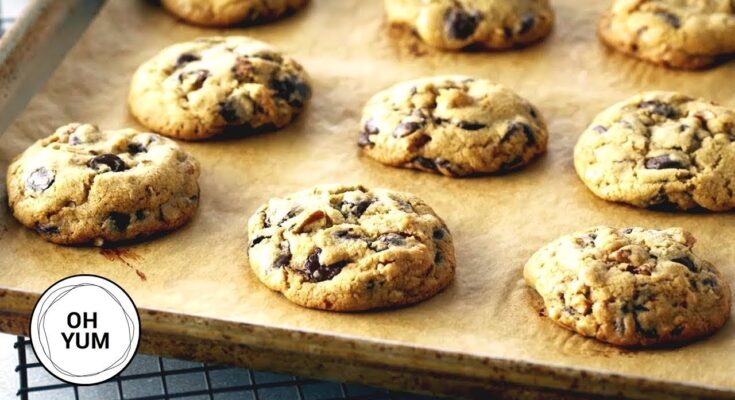Cookie Recipe: Who doesn’t love a warm, homemade cookie fresh out of the oven? Cookies have a timeless appeal, loved by kids and adults alike. Whether it’s for a celebration, a cozy snack, or a treat to share with friends, homemade cookies bring joy to any occasion. And the best part? Baking cookies is incredibly satisfying and achievable for bakers of all skill levels. Follow this step-by-step guide to make delicious cookies right in your own kitchen!
Essential Ingredients for Cookies
To bake cookies, you’ll need a handful of simple ingredients that most kitchens have on hand. Here’s a list of essentials:
- All-purpose flour: This is the foundation of the cookie, giving structure and texture.
- Granulated sugar and brown sugar: These add sweetness. Brown sugar provides moisture and a slight chewiness.
- Butter: Adds richness and enhances flavor. Unsalted is preferred for better control of salt levels.
- Eggs: Helps bind the dough and provides moisture.
- Baking soda or baking powder: This gives cookies their lift and slight fluffiness.
- Salt: Enhances all the other flavors in your dough.
- Vanilla extract: Adds a warm, aromatic sweetness.
Each ingredient plays a key role in achieving that perfect cookie texture—crisp on the edges and chewy in the center.
Baking Tools You’ll Need
Having the right tools will make the process smoother:
- Mixing bowls: Essential for combining ingredients without making a mess.
- Measuring cups and spoons: For accurate measurements of wet and dry ingredients.
- Hand or stand mixer: To cream the butter and sugar and mix the dough efficiently.
- Rubber spatula: Handy for scraping down the bowl.
- Cookie sheets or baking pans: Preferably non-stick or lined with parchment paper.
- Cooling rack: Essential for cooling cookies evenly.
Optional but useful tools include a cookie scoop for even portioning and parchment paper or silicone mats for non-stick baking.
Step-by-Step Cookie Recipe
Step 1: Preparing Your Workspace
Before starting, take a moment to organize your space. Measure out ingredients and line up your tools. This setup, called “mise en place,” helps keep you focused and prevents last-minute searches for missing items. Line baking sheets with parchment or silicone mats for easy cleanup.
Step 2: Measuring Ingredients Properly
Accurate measurements are critical in baking. Here are some quick tips:
- Flour: Spoon flour into your measuring cup, then level it off. Packing it down can result in too much flour, making cookies dense.
- Sugar: Scoop and level granulated and brown sugars as directed.
- Wet ingredients: Use liquid measuring cups for milk or oil, and pour at eye level to ensure precision.
Taking time to measure properly ensures each cookie batch turns out perfectly.
Step 3: Mixing the Dough
Start by creaming the butter and sugar together. Beat until light and fluffy—this creates air pockets that help with texture. Then add eggs and vanilla, mixing until smooth. Gradually add dry ingredients (flour, baking soda, salt), mixing gently to avoid overworking the dough. Over-mixing can lead to tough cookies, so aim for just combined.
Step 4: Adding Flavor Mix-ins
Now comes the fun part—adding your favorite mix-ins! Here are some ideas:
- Chocolate chips: A classic choice, semi-sweet or milk chocolate works best.
- Nuts: Chopped walnuts, pecans, or almonds add crunch.
- Spices: A pinch of cinnamon or nutmeg can elevate flavors.
Fold mix-ins gently into the dough to avoid toughening it. The options here are nearly endless—feel free to get creative!
Step 5: Chilling the Dough
Chilling the dough helps prevent cookies from spreading too much in the oven, resulting in a thicker, chewier texture. Cover the bowl with plastic wrap and place it in the fridge for at least 30 minutes, though an hour or more can be even better. If you’re short on time, 10 minutes in the freezer will help.
Step 6: Shaping the Cookies
Once your dough is chilled, it’s time to shape the cookies. Here are a few tips:
- Scooping the dough: Use a cookie scoop or a tablespoon to portion out uniform balls of dough. This ensures that all cookies bake evenly.
- Rolling into balls: For a smooth, round finish, roll each scoop into a ball between your hands.
- Flattening (if desired): Some cookies, like sugar cookies, benefit from a light press with a fork or your palm. However, if you’re making chocolate chip cookies, leave them as rounded balls so they retain their chewy centers.
Uniformity is key here. If you make your cookies different sizes, they won’t bake evenly, so take the time to make them as consistent as possible.
Step 7: Baking the Cookies
Preheat your oven to 350°F (175°C) and position your rack in the center of the oven for even baking. Place your shaped cookie dough balls on a baking sheet, leaving about two inches between each to allow for spreading.
- Baking time: Most cookies bake within 10-12 minutes, but check them a little earlier if you’re aiming for a softer center.
- Halfway rotation: If you notice uneven baking, rotate the baking sheet halfway through the cooking time.
Keep an eye on the cookies as they bake. Each oven varies, so use the baking time as a guideline and rely on visual cues to determine doneness.
Step 8: Checking for Doneness
Knowing when your cookies are perfectly baked is essential to achieving that ideal texture. Here are some signs to look for:
- Edges are set and golden: The edges should be slightly golden brown but not dark.
- Center is slightly soft: The middle should look a bit underdone. It will continue to set as it cools.
- Press test: Gently press down on the top; if it springs back slightly, they’re good to go.
Avoid over-baking, especially if you prefer softer cookies. They might look a little underdone when you take them out, but they’ll firm up on the baking sheet as they cool.
Step 9: Cooling and Handling Cookies
Let the cookies cool on the baking sheet for about five minutes before transferring them to a cooling rack. This initial cooling time allows them to set without crumbling. Here’s why cooling is crucial:
- Prevents breakage: Moving them while too warm can cause them to fall apart.
- Ensures chewy texture: Cooling slowly on the baking sheet lets the centers stay soft and chewy.
After five minutes, transfer the cookies to a cooling rack to cool completely. If you don’t have a rack, leave them on a parchment-lined counter for similar results.
Decorating Your Cookies
If you want to make your cookies even more festive or visually appealing, decorating is a fun step! Here are some decoration ideas:
- Icing: A simple glaze or royal icing can be drizzled or piped on for a professional look.
- Sprinkles: Add color by sprinkling before baking or pressing in after cooling.
- Chocolate drizzle: Melt chocolate and drizzle over cooled cookies for an elegant finish.
- Powdered sugar dusting: Lightly dust with powdered sugar for a classic look, especially on cookies like snickerdoodles or shortbread.
Decorating can be as simple or elaborate as you like. For added fun, involve kids or friends in the process for a memorable baking experience.
Storing Your Cookies
Proper storage is key to keeping your cookies fresh and tasty. Here are some tips for short-term and long-term storage:
- Room temperature: Store cookies in an airtight container at room temperature. They’ll stay fresh for 3-5 days.
- Freezing: For longer storage, place cookies in a single layer on a baking sheet and freeze until solid. Then transfer to a freezer-safe bag or container, separating layers with parchment paper. Cookies can be frozen for up to 3 months.
- Reheating: For a fresh-from-the-oven taste, warm cookies in the microwave for 10-15 seconds after thawing.
Storing cookies properly not only preserves freshness but also ensures that you’ll have a treat ready whenever you need it!
FAQs Cookie Recipe
1. Can I make cookie dough ahead of time?
Yes! Cookie dough can be made in advance and stored in the refrigerator for up to 3 days or frozen for up to 3 months. Simply roll into balls and freeze on a baking sheet before transferring to a bag. You can bake from frozen, just add an extra 1-2 minutes to the bake time.
2. Why do my cookies spread too much during baking?
Cookies can spread if the dough is too warm, the butter is too soft, or if there isn’t enough flour. Chilling the dough and measuring ingredients accurately can help. If it continues to happen, try reducing the baking temperature slightly.
3. How can I make cookies more chewy?
Using more brown sugar, adding an extra egg yolk, and underbaking slightly can result in chewier cookies. Avoid over-mixing the dough and allow the cookies to cool on the baking sheet to retain moisture.
4. What can I substitute for butter in cookie recipes?
You can substitute butter with margarine, shortening, or coconut oil in equal amounts. Be aware that the flavor and texture may differ slightly. Coconut oil will add a mild coconut flavor and may result in a slightly crispier texture.
5. Do I need to use parchment paper or a silicone baking mat?
While not essential, parchment paper and silicone mats prevent sticking and promote even baking. They’re helpful for easy cleanup and preventing the bottoms of the cookies from browning too much. If you don’t have these, lightly greasing your baking sheet can also work.
Conclusion
There’s something magical about biting into a cookie you made yourself. From mixing and shaping to baking and decorating, each step adds a bit of love to the process. Homemade cookies offer a chance to experiment, share, and satisfy that sweet craving in the best way possible. So go ahead, gather your ingredients, follow the steps, and enjoy the delicious results of your hard work!



